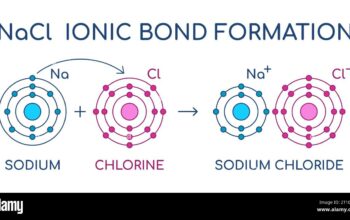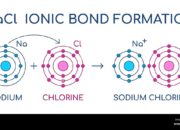Atoms, the fundamental building blocks of matter, engage in chemical bonding to form molecules and compounds that constitute the diverse array of substances in our universe. The intricate dance of electrons between atoms leads to various types of chemical bonds, each with distinctive properties and roles in the structure and behavior of matter. This discourse delves into the multifaceted mechanisms by which atoms bond, categorizing these interactions into three primary types: ionic bonds, covalent bonds, and metallic bonds. Furthermore, we shall explore the nuances of each bond type, their formation processes, and their implications in broader chemical contexts.
Ionic Bonds: An Electrostatic Attraction
Ionic bonding arises when atoms transfer electrons, resulting in the formation of charged ions. This process typically occurs between elements of vastly different electronegativities, particularly between metals and nonmetals. In this scenario, a metal atom, exhibiting a low electronegativity, relinquishes one or more of its electrons to a nonmetal atom, which possesses a high electronegativity and a strong tendency to attract electrons.
For instance, when sodium (Na) encounters chlorine (Cl), sodium loses its lone valence electron, becoming a positively charged sodium ion (Na+), while chlorine gains an electron to become a negatively charged chloride ion (Cl–). The resulting oppositely charged ions are held together by electrostatic forces, forming an ionic compound, sodium chloride (NaCl). The lattice structure of ionic compounds is characterized by a repeating pattern of ions, which contributes to their high melting and boiling points, as well as their electrical conductivity when dissolved in water.
Covalent Bonds: Sharing Electrons
In contrast to ionic bonding, covalent bonding is characterized by the sharing of electron pairs between atoms. This type of bond generally forms between nonmetals, which possess similar electronegativities. By sharing electrons, atoms can achieve a full valence shell, leading to greater stability. Covalent bonds can be classified into single, double, and triple bonds, depending on the number of shared electron pairs.
For example, in the formation of a water molecule (H2O), each hydrogen atom shares one electron with the oxygen atom, leading to the establishment of two single covalent bonds. Moreover, in a molecule like ethylene (C2H4), the carbon atoms share two pairs of electrons, resulting in a double bond. The strength and stability of covalent bonds make them pivotal in organic chemistry, where molecular structure dictates functionality and reactivity.
The polarity of covalent bonds also merits attention. When atoms with differing electronegativities participate in covalent bonding, the shared electron pair may be more closely associated with one atom than the other, leading to the formation of polar covalent bonds. This asymmetry creates dipoles, which have implications in molecular interactions, such as hydrogen bonding and solubility.
Metallic Bonds: A Sea of Electrons
In metallic bonding, atoms within a metal lattice share and delocalize their valence electrons, resulting in a “sea of electrons.” This phenomenon enables metals to exhibit unique properties, such as electrical conductivity, malleability, and ductility. The positive metal ions are situated in a regular pattern, while the delocalized electrons facilitate movement throughout the lattice.
Consider the example of sodium metal, where the metallic bond allows the formation of a structure in which the sodium ions are surrounded by a cloud of free electrons. This electron mobility accounts for the ability of metals to conduct electricity, as these electrons can move freely when a potential difference is applied. Moreover, the presence of metallic bonds imbues metals with their characteristic strengths, making them suitable for a myriad of industrial applications.
Other Bonding Concepts: Coordination and Hydrogen Bonds
Beyond the primary bond types, several other bonding concepts enhance the understanding of atomic interactions. Coordination bonds, for instance, occur when a ligand, possessing a lone pair of electrons, donates its electrons to a central metal ion, forming a complex. This type of bonding is fundamental in biochemistry, particularly in the functionality of metalloproteins and catalysts.
Hydrogen bonds represent a vital yet weaker intermolecular force rather than a definitive bond type. These interactions arise when a hydrogen atom, covalently bonded to a highly electronegative atom like oxygen or nitrogen, is attracted to another electronegative atom in a nearby molecule. Hydrogen bonding is critical in biological systems, influencing the structure of water, the formation of secondary protein structures, and the behavior of nucleic acids.
Conclusion: The Significance of Chemical Bonding
The formation of chemical bonds is integral to the structure and function of all matter. Understanding the mechanisms behind ionic, covalent, and metallic bonds, as well as other interactions, unlocks insights into the properties and behaviors of substances. The interplay of bonded atoms shapes the physical characteristics, reactivity, and roles of various compounds, ultimately contributing to the complexity and diversity of the chemical world. As research continues to evolve, the exploration of chemical bonding remains a crucial endeavor in elucidating the intricate tapestry of matter that surrounds us.












